Returning to the boat ramp, dejected and bewildered after yet another fruitless session targeting bream on lures in the Barwon River, I vowed never to return.
Somewhat reluctantly, however, I continued motoring downstream towards the iconic Barwon Heads Bridge and began searching for a few fish in a last ditch attempt to satisfy a craving for some bent rod action.
Much to my surprise, the first cast yielded a strike from a juvenile salmon and I continued catching fish on a range of lures all afternoon. As the tide bottomed out and the sun disappeared behind the bluff, a rampant school of sambos became so charged up and agitated, that even cranking the reel at full speed resulted in multiple fish honing in on the lure in classic pelagic attack mode.
Needless to say, my earlier frustrations were quickly forgotten and I’ve since developed a newfound respect for this system.
The Barwon River begins in the Otways National Park near Gerangamete Flats in Southern Victoria at an elevation of 136m. Flowing through farmland and winding its way through the townships of Forrest, Birregurra and Geelong, 15 feeder creeks and smaller rivers flow into the Barwon River over its 145km journey to the sea.
The mouth of the system enters the Southern Ocean approximately 100km southwest of Melbourne at the twin townships of Ocean Grove and Barwon Heads. The lower reaches of the Barwon estuary is a popular beachside holiday destination for tourists and an ideal location for swimming, canoeing, boating, and of course fishing.
Extensive sand flats, bicycle paths, walking tracks and boardwalks provide excellent access for land-based anglers on either side of the estuary.
Vehicle access is available via Flinders and River parades in Barwon Heads and Peers Crescent in Ocean Grove. There are a few jetties and designated fishing platforms dotted along the system and two major boat ramps servicing the river.
There is a dual lane ramp at Ocean Grove, accessible via Guthridge Street, which is capable of handling larger vessels heading offshore. The ramp is equipped with ample car and trailer parking, a floating jetty, toilet facilities and fish cleaning benches. The Barwon Heads ramp is accessible via River Parade and better suited to smaller craft. This facility is equipped with a floating jetty, gravel car park and a separate fishing platform.
The river is navigable from the mouth up to Lake Connewarre, which is usually too shallow for most boats. While channel markers provide guidance for mariners downstream of the Ocean Grove ramp, it is still advisable to exercise caution, particularly at low tide. It’s also worth noting that a strict speed limit of just 5 knots applies to all powered craft.
Mulloway, bream and elephant fish have put the Barwon River on the angling map over the years, but salmon, trevally and whiting are more reliable targets for visiting anglers and holiday-makers. Plenty of mullet frequent the system, while a few flathead, pinkie snapper and juvenile barracouta also make an occasional appearance. Limited numbers of estuary perch are also known to reside further upstream, while carp, redfin, tench, eels and a few brown trout are available throughout the freshwater sections closer to Geelong.
From a bream luring perspective, the Barwon estuary seems devoid of obvious fish-holding structure and has been a source of frustration for many anglers over the past few years. There are next to no snags and it is relatively shallow for such a large system. The lower reaches are laced with sandbars and are subject to incredibly strong tidal flows.
Though patches of rubble, extensive sand flats, some deeper holes, weed beds and a few mangrove lined creeks do provide habitat for bream, most fish are taken on live Bass yabbies, crabs or sand worms. Admittedly my motivation to persist with lures has waned after several fruitless sessions.
Consequently, I’ve only encountered one solitary bream on a soft plastic in the Barwon River, and know of just a few locals who have experienced very limited success in this department. While estuary systems further east and west are highly productive bream fisheries for lure enthusiasts, the Barwon bream are an enigma to many, especially when it comes to fooling them with artificials.
We’ve all been guilty of single-mindedly pursuing a particular species or employing a specific technique for hours on end, only to return disappointed on difficult day. While persistence and perseverance are admirable qualities, flexibility and a preparedness to change tactics or alter expectations can be your greatest asset in tough conditions.
Although I haven’t given up entirely on the seemingly elusive Barwon bream, my attention has shifted somewhat in recent times to the ravenous schools of salmon and silver trevally that reside in the system for much of the year. Driven by an unrelenting desire to feed and always on the lookout for an easy meal, salmon can be a real saviour.
Fighting well beyond their weight class, silver trevally are also ideal targets for Victorian sports anglers. They provide some terrific sport on light gear and the larger specimens are often receptive to a well-presented lure or soft plastic.
While huge schools of salmon can turn up anywhere at anytime, the peak feeding period usually coincides with a run out tide in areas where water drains off the shallow flats, creating a bottle neck at the mouth of feeder creeks, channels or indeed the entrance to the estuary itself.
Bait fishing and trolling is highly productive in the Barwon estuary, but casting soft plastics is by far the most effective and versatile method in terms of locating schools and accumulating some incredible catch and release bags. However, as far as the visual appeal is concerned, there’s nothing quite like watching a salmon engulf a surface lure, be it a soft plastic, popper or walk-bait.
Rather surprisingly perhaps, casting walk-the-dog style surface lures is a very effective searching method in open water. Even while holding in deeper channels, salmon tend to keep a close eye on the overhead activity and are usually more than willing crunch a prawn, shrimp or baitfish profile surface presentation.
In general, poppers are better suited to rough and windy conditions, while the side to side swaying action of a well presented walk-bait draws plenty of attention in calmer water. Although salmon are fast movers and generally prefer a steady retrieve, pausing the lure often turns follows and bumps into aggressive surface strikes and solid hook-ups.
Whereas hoards of undersize fish can be a source of frustration for bait anglers, most salmon encountered in the estuary on surface lures range from 30-40cm, with larger specimens up to 1.5kg a rarity, but by no means impossible.
Schools of silver trevally are never too far away, as they often follow the salmon up and down the system, mopping up pieces baitfish as the fall through the water column. Soft plastics and hardbodied lures have produced some thumping trevally of late, particularly during the first two hours of the incoming tide.
Trolling is also productive at times and I’ve heard of a few anglers who have taken trevally on winged trout lures, which is very unusual. Although I prefer to cast and retrieve, towing lures back to your mark after drifting with the wind or current can produce a few bonus fish.
The next time you’re getting stuck into a few salmon close to the surface, be sure to search a little deeper for the silver slabs lurking below. Whiting and the odd mullet are also encountered on lightly weighted soft plastics underneath schools of salmon.
This is an exciting time to be on the water and while other species often take precedence, don’t underestimate the sportfishing attributes of Australian salmon and silver trevally. In between snapper sojourns, surf fishing excursions or bream luring expeditions, schedule in a day trip or plan an extended visit to Barwon Heads.
While the size of the fish won’t break any records, their enthusiasm and willingness to engage a range of lures and retrieve techniques is sure to get the adrenalin pumping. Further to that, perhaps you’ll have more luck demystifying the enigmatic Barwon bream and mulloway secrets of yesteryear.
Facts
Accommodation and Supplies
Barwon Heads Caravan Park
Ewing Blyth Drive, Barwon Heads
Ph: 03 5254 1115
Email: --e-mail address hidden--
Riverview Family Caravan Park
Barwon Heads - Ocean Grove Rd, Ocean Grove
Ph: 03 5256 1600
Email: --e-mail address hidden--
Barwon Estuary Boat Hire
River Parade, Barwon Heads
Ph: 0407 422 298
Email: --e-mail address hidden--
Queenscliff Bait and Tackle
2 Hesse Street, Queenscliff
Ph: 03 5258 5331
Email: --e-mail address hidden--
Facts
Tackle, Lures and Soft Plastics
Rods and Reels
2-5 kg graphite spinning rods ranging from 6-7 ft in length, matched to a 1000-3000 size reel.
Line and Leader
4-6lb Berkley Fire-Line and 6-10lb Fluorocarbon Leader
Surface Lures
Lucky Craft 65mm Sammy
River 2 Sea 65mm Bubble Popper
River 2 Sea 75mm Rover
Soft Plastics
Atomic 2” Fat Grub
Berkley Powerbait 3-4” Dropshot Minnow
Berkley Gulp! 3-4” Power Minnow
Hardbodied Lures
IMA Tetra TD
Ecogear SX40F
Jackall Bros Chubby Deep
The peak feeding period usually coincides with a run out tide in areas where water drains off the shallow flats, creating a bottleneck at the mouth of feeder creeks, channels or indeed the entrance to the estuary itself.

Soft plastics and hardbodied lures have produced some thumping trevally of late, particularly during the first two hours of the incoming tide.

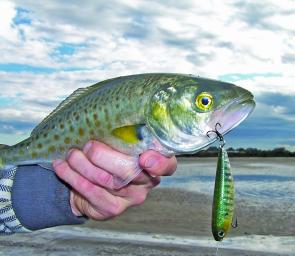
Casting walk-the-dog style surface lures is a very effective searching method in calm open water.
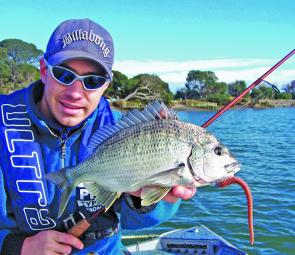
The Barwon bream are an enigma to many, especially when it comes to fooling them with artificials.
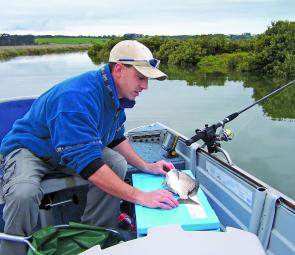
Most bream encountered in the Barwon estuary are taken on live Bass yabbies, crabs or sand worms.
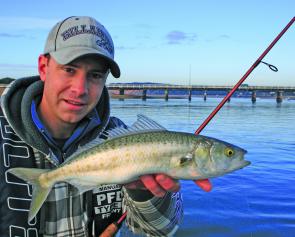
While the size of the fish won’t break any records, their enthusiasm and willingness to engage a range of lures is sure to get the adrenalin pumping.
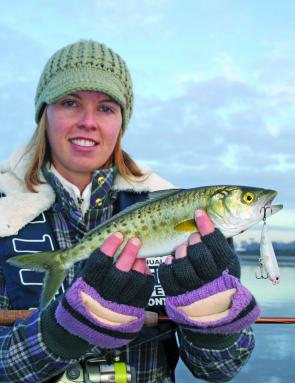
Rugged up for some cool conditions, Katrina Paton displays a typical Barwon River salmon taken on a walk-the-dog style surface lure.

– 5




